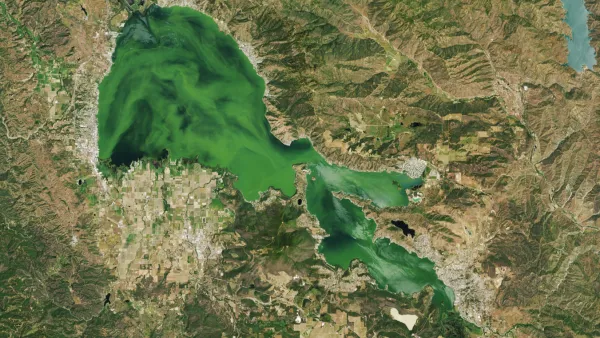Scientists hope to use AI and machine learning models to forecast water quality issues caused by toxic blue-green algae blooms.

According to the Los Alamos Reporter, scientists from the Los Alamos National Laboratory plan to use artificial intelligence modeling to forecast toxic algal blooms, which “[f]ueled by climate change and rising water temperatures … have grown in intensity and frequency” and “have now been reported in all 50 U.S. states.” Perhaps the most well-known occurrence of these harmful algal blooms, or HABs, happened in 2014, when dangerous toxin levels in Lake Erie forced Toledo, Ohio, to shut down the drinking water supply of a half-million residents for three days. Just last month, Clear Lake in California was in the news for its own blue-green algal bloom, which some fear will impact summer tourism activities.
“For decades, scientists have understood that elevated water temperatures, combined with sudden infusions of nutrients (often phosphorous and nitrogen runoff from industrial farming), tend to precede a HAB event …. But what causes toxic cyanobacteria to prevail in these freshwater ecosystems has proved challenging to understand” because they are “complex ecosystems influenced by hundreds — sometimes thousands — of other microorganisms,” the Los Alamos Reporter article reads. Armed with masses of data on HABs collected since 1954 by a variety of organizations across the nation and the world, the scientists plan to feed existing yet disparate information into a data learning model and use AI to decipher and analyze it.
“Such a model could then be used to forecast algal blooms, and possibly even predict how climate change will alter their intensity and frequency in the future,” said Babetta Marrone, senior scientist at the LANL and the project’s team lead, in a press release.
FULL STORY: LANL: AI Can Help Forecast Toxic ‘Blue-Green Tides’

National Parks Layoffs Will Cause Communities to Lose Billions
Thousands of essential park workers were laid off this week, just before the busy spring break season.

Retro-silient?: America’s First “Eco-burb,” The Woodlands Turns 50
A master-planned community north of Houston offers lessons on green infrastructure and resilient design, but falls short of its founder’s lofty affordability and walkability goals.

Delivering for America Plan Will Downgrade Mail Service in at Least 49.5 Percent of Zip Codes
Republican and Democrat lawmakers criticize the plan for its disproportionate negative impact on rural communities.

Test News Post 1
This is a summary

Test News Headline 46
Test for the image on the front page.

Balancing Bombs and Butterflies: How the National Guard Protects a Rare Species
The National Guard at Fort Indiantown Gap uses GIS technology and land management strategies to balance military training with conservation efforts, ensuring the survival of the rare eastern regal fritillary butterfly.
Urban Design for Planners 1: Software Tools
This six-course series explores essential urban design concepts using open source software and equips planners with the tools they need to participate fully in the urban design process.
Planning for Universal Design
Learn the tools for implementing Universal Design in planning regulations.
EMC Planning Group, Inc.
Planetizen
Planetizen
Mpact (formerly Rail~Volution)
Great Falls Development Authority, Inc.
HUDs Office of Policy Development and Research
NYU Wagner Graduate School of Public Service





























